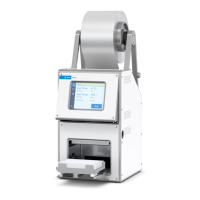15
PlateLoc Thermal Microplate Sealer
Frequently asked questions
Reference for Optimal Thermal Microplate Sealing
Chemical compatibility verification and validation
Q
We’d like to confirm the thermal microplate seal we have selected is chemically
compatible with our samples for long- term storage. Do you have a suggested
method?
A
Please see the Association for Laboratory Automation (ALA), Final Conference
Program, January 27–31, 2001. Page 276 of the PDF contains the abstract from
a poster paper generated by 3M with useful protocols for evaluating adhesive-
based microplate seals.
www.labautomation.org/conference/pdfs/LA2001Book.pdf
Another useful reference is Comparison of Microplate Sealing Tapes Using
Standardized Test Protocols [T- 41]. Terry W. Lewis, Maurice H. Kuypers,
Mialena M. Walker Medical Specialties Department 3M Health Care, St. Paul,
Minnesota.
http://lab- robotics.org/Presentations/3M/3M_comparison4.PDF
Sterile and RNase-/DNase-free microplate seal
Q
Do you sell microplate seals that are certified to be sterile as well as RNase- /
DNase- free?
A
No, not at this time. The majority of PlateLoc Sealer customers have been able
to use the existing materials. Agilent Technologies can develop seal materials
with these features, provided the customer is willing to invest the time and
substantial cost required to do so.
There are also costly technical challenges to offering materials such as
aluminium seals in a sterile format. Since e- beam sterilization cannot penetrate
aluminum very well, gamma radiation is the only practical solution. However,
the cost is substantial. Contact Agilent Technologies for more information.
Water bath thermal cycling
Q
Are Agilent Technologies thermal microplate seals compatible with water bath
thermal cycling?
A
The aluminium seal can be used for a limited time in a water bath, and the
clear seal for longer periods. However, the hot melt adhesive layer may be
damaged by prolonged exposure to water. Also, it is very important that no air
bubbles migrate into the gap between the seal surface and the top of the
microplate (the gap is due to the raised rim or chimney of the sample well).
For example, if two microplates are held vertically together (seal surface to
seal surface) and air bubbles rise into the gap between the seal and the
microplate surface itself, the expanding bubbles may apply force to the seal
which may loosen the seal. One workaround is to place a piece of conforming
foam between the two sealed microplates, held with sufficient force to prevent
the air bubbles from entering the gap between the seal and microplate top
surface.

